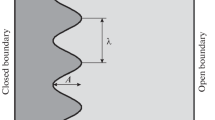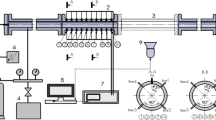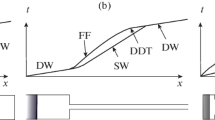Abstract
To study the effects of the boundary layer on the deflagration to detonation transition (DDT) process, the mixture behind an incident shock wave was ignited using laser breakdown. Ignition timing was controlled so that the interaction of the resulting flame with a laminar or turbulent boundary layer could be examined. In the case of the interaction with a laminar boundary layer, wrinkling of the flame was observed after the flame reached the corner of the channel. On the other hand, interaction with the turbulent boundary layer distorted the flame front and increased the spreading rate of the flame followed by prompt DDT. The inner structure of the turbulent boundary layer plays an important role in the DDT process. The region that distorted the flame within the turbulent boundary layer was found to be the intermediate region \(0.01< y/\delta < 0.4\), where y is the distance from the wall and \(\delta \) is the boundary layer thickness. The flame disturbance by the turbulent motions is followed by the flame interaction with the inner layer near the wall, which in turn generates a secondary-ignition kernel that produced a spherical accelerating flame, which ultimately led to the onset of detonation. After the flame reached the intermediate region, the time required for DDT was independent of the ignition position. The effect of the boundary layer on the propagating flame, thus, became relatively small after the accelerating flame was generated.














Similar content being viewed by others
References
Urtiew, P.A., Oppenheim, A.K.: Experimental observations of the transition to detonation in an explosive gas. Proc. R. Soc. Lond. A 295, 13–28 (1966)
Liberman, M.A., Kuznetsov, M.S., Ivanov, A., Matsukov, I.: Formation of the preheated zone ahead of a propagating flame and the mechanism underlying the deflagration-to-detonation transition. Phys. Lett. A 373, 501–510 (2009)
Liberman, M.A., Ivanov, M.F., Kiverin, A.D., Kuznetsov, M.S., Chukalovsky, A.A., Rakhimova, T.V.: Deflagration-to-detonation transition in highly reactive combustible mixtures. Acta Astronaut. 67, 688–701 (2010)
Nettleton, M.A.: Gaseous Detonations: Their Nature, Effects and Control, pp. 128–129. Chapman Hall, New York (1987)
Gooderum, P.: An experimental study of the turbulent boundary layer on a shock-tube wall. NACA TN 4243 (1958)
Fay, J.A.: Two-dimensional gaseous detonations: Velocity deficit. Phys. Fluids 2, 283–289 (1959)
Kuznetsov, M.S., Alekseev, V.I., Matsukov, I., Dorofeev, S.B.: DDT in a smooth tube filled with a hydrogen-oxygen mixture. Shock Waves 14, 205–215 (2005)
Ishihara, S., Tamura, S., Ishii, K., Kataoka, H.: Deflagration to detonation transition behind an incident shock wave by forced ignition. International Colloquium on the Dynamics of Explosions and Reactive Systems. Paper No. 194 (2013)
Ishii, K., Kataoka, H., Kojima, T.: Initiation and propagation of detonation waves in combustible high speed flows. Proc. Combust. Inst. 32, 2323–2330 (2009)
Ishii, K., Morita, K., Okitsu, Y., Sayama, S., Kataoka, H.: Cellular pattern formation in detonation propagation. Proc. Combust. Inst. 34, 1903–1911 (2013)
Mirels, H., Mullen, J.F.: Small perturbation theory for shock-tube attenuation and nonuniformity. Phys. Fluids 7, 1208–1218 (1964)
Hartunian, R.A., Russo, A.L., Marrone, P.V.: Boundary-layer transition and heat transfer in shock tubes. J. Aerosp. Sci. 27, 587–594 (1960)
Klebanoff, P.S.: Characteristics of turbulence in a boundary layer with zero pressure gradient. NACA Rep. 1247 (1955)
Author information
Authors and Affiliations
Corresponding author
Additional information
Communicated by G. Ciccarelli.
Rights and permissions
About this article
Cite this article
Ishihara, S., Tamura, S., Ishii, K. et al. Effects of boundary layer on flame propagation generated by forced ignition behind an incident shock wave. Shock Waves 26, 599–609 (2016). https://doi.org/10.1007/s00193-016-0684-6
Received:
Revised:
Accepted:
Published:
Issue Date:
DOI: https://doi.org/10.1007/s00193-016-0684-6




